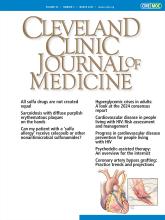First, we would like to thank Dr. Param Darpan Sheth for the commendations and, just as important, for the insightful and clinically important questions and comments.
There is no question that the earlier the diagnosis of diabetic ketoacidosis (DKA), the quicker the resolution of acute symptoms. To attempt to establish a quicker diagnosis, there must be a high degree of suspicion. Practically, a patient admitted to an emergency department will have a basic electrolyte panel: a low bicarbonate and increased anion gap are immediately identified. Checking for urine ketones, while quick, is not necessarily very helpful because sodium-glucose cotransporter (SGLT) 2 inhibitors induce ketosis and the turnaround time for serum ketones delays initiation of appropriate therapy.
Our recommendation is that the presence of low bicarbonate (< 20 mmol/L), increased anion gap, and blood glucose less than 200 mg/dL allows a presumptive diagnosis and requires starting a dextrose-containing intravenous fluid—normal saline if the potassium exceeds 5.5 mmol/L or Ringer’s lactate if the potassium is lower. This will induce endogenous insulin secretion and provide the glucose to stop ketogenesis.
It is difficult to mandate insulin administration to non-endocrinologists, but it can be mandated that any patient with ketoacidosis and a blood glucose less than 200 mg/dL be given a nonpeaking insulin like glargine or degludec at a dose of 20% of the body weight in kilograms. This is based on the physiologic principle that any ketoacidosis requires a relative insulin deficiency in relation to glucagon, and administered insulin will go a long way to correct that imbalance.
The risk of hypoglycemia is very low given that any excess insulin is counterbalanced by the suppression of endogenous insulin secretion and the glucose infusion, as well as the fact that peakless basal insulins control hepatic glucose output but are poor at disposing of glucose from the circulation when used in low doses. In fact, national guidelines recommend the continuation of basal insulin during the treatment of full-blown DKA,1 which is also indicated in our paper.2 Even if the unmeasured ion comprising the increased anion gap is lactic acidosis, a basal insulin has been shown to be advantageous. Instituting an insulin infusion is indicated once the beta-hydroxybutyrate level has been established, and this would not be adversely affected by the presence of the basal insulin.
These approaches, based on the first laboratory tests on arrival in the emergency department, treat the physiologic basis of ketoacidosis from the start: lack of glucose and relative insulin deficiency and dehydration. And they do so with a very low risk of hypoglycemia. Of course, once capillary point-of-care ketone meters, which are under development, become less expensive and more universally available, delays in diagnosis will become moot.
The comment on ketones is quite germane. There is a very thin line between the advantages of ketonemia and the disadvantages of ketoacidosis. SGLT-2 inhibitors blur the line further. Ketones, being strong acids, will decrease bicarbonate. Therefore, starting SGLT-2 inhibitors in patients with a bicarbonate level less than 21 mmol/L is asking for trouble. As well, ketones are an efficient secondary fuel, requiring less oxygen to be metabolized to form adenosine triphosphate. However, this is done in muscle: a low creatinine de novo or in relation to blood urea nitrogen predicts a low muscle mass. The latter is important in the very elderly, in whom sarcopenia may be masked by muscle fibrosis, thus making weight a poor marker of sarcopenia. Unfortunately, creatinine loses its predictive value at presentation with ketoacidosis because of the associated dehydration.
With regard to guidelines, we could not agree more. The therapeutic measures discussed above are based on physiologic principles, and our approach is based on these principles, not on guidelines. With the wider use of SGLT-2 inhibitors in conditions without attendant hyperglycemia, it is important that relevant professional organizations recognize the greater frequency of ketoacidosis and develop a consensus and physiologically sound guidelines.
- Copyright © 2025 The Cleveland Clinic Foundation. All Rights Reserved.






